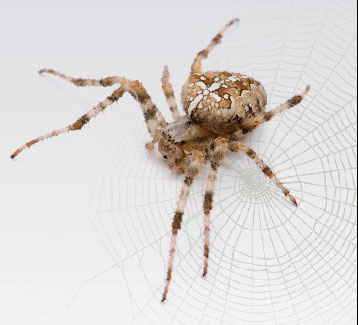It’s an attractive web they weave

Spider webs aren’t static—they actively spring towards their prey thanks to electrically-conductive glue spread across their surface, according to Oxford University researchers.1 Their paper in Naturwissenschaften shows how the electrostatic properties of the glue and ‘a quirk of physics’ causes webs to move towards all airborne objects, irrespective of whether they are positively or negatively charged.2
These new findings explain why spider webs are such efficient collectors of small airborne particles such as pollen, and why they suddenly spring towards nearby flying insects.
“People often underestimate the static electricity that builds up in airborne objects, but it is important at all scales,” explained Professor Fritz Vollrath of Oxford University, who led the study. “The Hindenburg disaster might have been caused by a discharge of static electricity,3 and helicopters have been known to explode suddenly when landing. Everything that moves through the air develops static charge, so it’s fascinating to see how spider webs make use of this to actively catch prey.”1
Vollrath and his Oxford colleague, Donald Edmonds, demonstrated that the glue-coated capture spiral of the orb web of the garden cross spider4 Araneus diadematus remains electrically conductive even when the thread is stretched.
It would surely be reasonable to conclude that the web glue’s electrostatic properties, and the ‘quirk of physics’ referred to, were no accident, but by design. And for anyone studying spiders and their webs, there’s surely “no excuse”5 for thinking otherwise given what we already knew about them. For example, the amazing multi-functional nature and variable strength of the web-covering glue,6 along with the web’s staggeringly strong fibres7 and their heat resistance,8 and the spider’s own spectacularly foot-sure ‘stickiness’.9

What’s more, in light of this latest research it’s easier to envisage how, in the pre-Fall world, efficient capture of pollen and airborne particulates might well have provided for spiders’ dietary/nutritional needs. Some biblical creationists believe that spiders didn’t always eat insects, as there was no death of any creatures before Adam sinned. However, while there was no death of any nephesh chayyah (נפשׁ חיה) animal life before the Fall, which certainly includes birds and various animals of the field, the Bible does not definitively say that insects have nephesh life. It is noteworthy though that pollen makes up about 25% of the diet of adult orb web spiders,10 and a higher percentage in baby orb weavers.11 Indeed, there is even a mainly vegetarian spider.12 It is easy to understand how such could be a legacy of the pre-Fall world.
But back to today’s post-Fall world: Professor Vollrath noted that “the elegant physics of these webs” was “a great bonus” for humanity, regarding airborne pollutants. “Electrical attraction drags these particles to the webs, so you could harvest and test webs to monitor pollution”. Thus spider webs provide us with “a cheap and natural way of tracking pesticides and air quality around the world.”1
References and notes
- How electricity helps spider webs snatch prey and pollutants, University of Oxford news release, www.ox.ac.uk, 8 December 2013. Return to text.
- Vollrath, F., and Edmonds, D., Consequences of electrical conductivity in an orb spider’s capture web, Naturwissenschaften, doi:10.1007/s00114-013-1120-8, 2013. Return to text.
- The Hindenburg disaster was the destruction by fire of the German passenger airship LZ [Luftschiff (airship) Zeppelin] 129 Hindenburg on 6 May 1937, as it was attempting to dock at the Lakehurst Naval Station, New Jersey, USA. Return to text.
- Also known colloquially as the European garden spider, diadem spider, cross orbweaver. Return to text.
- Romans 1:20. Return to text.
- Sarfati, J., Spiderweb stickiness secret, Creation 33(2):34–35, 2011; creation.com/spiderweb-stickiness. Return to text.
- Sarfati, J., God’s webspinners give chemists free lessons, Creation 23(2):20–21, 2001; creation.com/spidersilk. Return to text.
- Hot spider silk, Creation 27(3):9, 2005; creation.com/spidersilk-hot. Return to text.
- Sarfati, J., Spectacular spider stickiness, Creation 27(4):54–55, 2005; creation.com/spiderstick. Return to text.
- Eggs, B. and Sanders, D., Herbivory in spiders: The importance of pollen for orb-weavers, PLOS One 8(11):e82637, 2013. Return to text.
- White, T., Pollen-eating spiders, Nature Australia 26(7):5, Summer 1999–2000. Pollen-eating spiders, Creation 22(3):5, 2000; creation.com/spiders-pollen. Return to text.
- Meehan, C.J. et al., Exploitation of the Pseudomyrmex-Acacia mutualism by a predominantly vegetarian jumping spider (Bagheera kiplingi), 93rd ESA [Ecological Society of America] Annual Meeting, 7 August 2008; Current Biology, 2009; Catchpoole, D., Vegetarian spider, Creation 31(4):46, 2009; creation.com/vegetarian-spider. Return to text.




Readers’ comments
Comments are automatically closed 14 days after publication.